February 2003 (Part 3)
SELECTION OF QUESTIONS AND ANSWERS
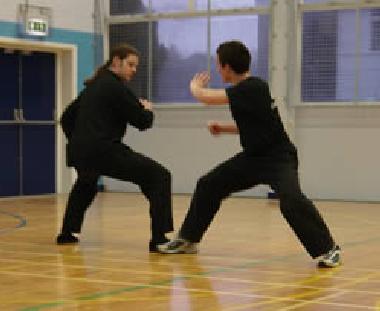
If we practice kungfu, logically we use kungfu patterns, including proper stances, for “san da” or free sparring.
Question 1
Can you please tell me how to develop kungfu force.
— Rumi, USA
Answer
We may divide kungfu force development into two major categories, external training and internal training.
External force training involves such exercises like stretching, hitting a sand bag, striking your arms and legs against poles or a wooden dummy, push-ups and running.
Internal force training involves such exercises like stance training, generating energy flow, building a pearl of energy at the dan tian, “Pushing Mountains” and “Sinew Metamorphosis”.
In our school, Shaolin Wahnam, we focus on internal training. But internal training needs to be attempted under the supervision of a master. It is not advisable for you to learn it through an e-mail, books, videos or incompetent instructors, because it is likely you may injure yourself unknowingly.
If you wish to train on your own, you may attempt external training. Although you can still injure yourself and the results are inferior to those from internal training, it is safer than internal training.
Three external exercises you can attempt are stretching, punching a sandbag, and striking your arms against a pole. These are not the usual exercises we do in Shaolin Wahnam, but are recommended to you if you do not have an opportunity to learn internal training from a master.
Stretch your legs daily for about five minutes. You can use any suitable, common stretching exercise, like touching your toes while standing with your feet together and legs straight, and placing one leg on a support at waist level and bending your body forward so that your face can touch the knee of the raised leg.
Then “sit” at a Horse-Riding Stance or a Bow-Arrow Stance and punch at a suspended sandbag with your two fists alternately. Do not move your body, and do not tense your muscles while punching. These two instructions are important if you wish to follow and benefit from Shaolin training principles, though martial artists of other systems may throw their body forward and tense their muscles to use muscular strength when punching.
Start with 30 punches and gradually work up to 300 punches daily. After training, apply medicated wine onto your hands or soak them in medicated concoction. Let the wine or concoction dry by itself, and avoid in contact with water until your hands have been dried for about half an hour.
If medicated wine or medicated concoction is not available, a poor substitute is to wash and massage your hands, especially your knuckles, in warm water with a pinch of salt added to it. This is important for overcoming energy and blood blockage, and for preventing possible deformation of your hands due to prolonged conditioning.
Some martial artists have powerful punches, but their hands are deformed and they suffer pain at their hands occasionally. According to Shaolin philosophy, their training was incorrect, and they committed the mistake of hurting themselves even before they could apply their force in combat. You should avoid such a mistake.
A third external exercise is to strike your arms against a pole. At a suitable stance and swing your arms at the pole, striking it with various parts of your arms. It is important that you must not tense your muscles. Start with a comfortable number of strikes, say 30, and gradually work up to 300. Apply medicated wine, soak your arm in medicated concoction, or at least massage in warm water after training.
Although we in Shaolin Wahnam consider these training methods low-level, if you practice these three methods daily for a year, you would be quite powerful. When you spar with blackbelts, even if you block their punches and kicks clumsily, they would complain you hurt them.
Some of those who only read about martial arts but never put effort into actual training, or who only perform kungfu forms but never develop force and combat application, and who view a blackbelt as a formidable fighter, may ridicule the above statement about hurting a blackbelt with your blocks. But if you have patience to practice for a year what I have described, you can readily verify the truth or otherwise of my advice.
Question 2
I have been practicing some Chi-kung for the last 6 years. One teacher told me not to drink water during dynamic chi-kung and Zhang Zhuang and to wait at least 30 minutes after finishing the exercises. What is your advice?
— Jadish. Spain
Answer
Different schools and teachers have different advice. Some teachers advise that one should not drink cold or iced water before and after chi kung practice, because cold drinks slow down or impede chi flow. Warm water, on the other hand, is permissible.
In our school, Shaolin Wahnam, this abstinence from cold drinks is not necessary. While cold drinks impede chi flow, the chi flow generated from our chi kung training is so strong that this impediment is marginal.
Our philosophy is that if before practicing chi kung you can do something — like having cold drinks, sugar or sex — without harmful effect, it does not make sense to abstain from them when you start practicing chi kung, which is supposed to make you stronger and healthier.
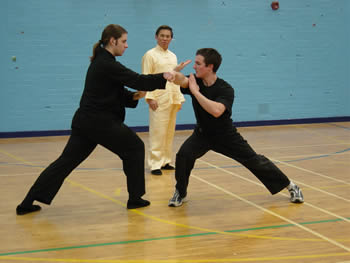
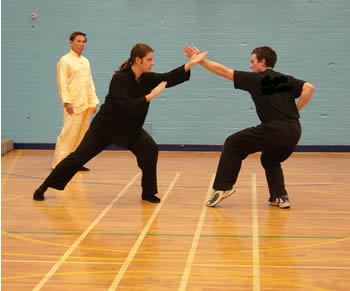
The answers to both questions are “yes” if you have been properly and sufficiently trained, as shown in the above two photographs where Dan Hartwright and Ronan Sexton are engaged in “san da” or free sparring. Dan and Ronan are the Shaolin Kungfu instructor and the assistant instructor of Shaolin Wahnam England.
Question 3
Sifu, many people say that San Da is a reflection of Shaolin Kungfu's nature of adapting and changing. They say that fights do not play out the way they used to, fighting has changed and so a lot of Shaolin Kungfu is obsolete. They say that there is a lot Shaolin Kungfu can learn from Western Boxing. Please could you give your opinions?
— Dan, United Kingdom
Answer
This question reflects a diametrically opposing view between the main critics in the discussion forum and our Shaolin Wahnam school.
San da, which literally means “miscellaneous hitting”, is actually the Chinese term for free sparring. It has been a part of kungfu training since ancient time. In fact, in the past san da was more important than set practice. Much of our own kungfu training in Shaolin Wahnam is san da.
San da refers to exchanges of attack and defence between two or more practitioners without any pre-arrangement and using any movements from any martial systems or freestyle. In other words, an attacker attacks in any way and at any time he likes, and the defender responds accordingly, including counter attacking. If they practice kungfu, logically they will use kungfu skills and techniques for san da. When they meet to attack and defend, and then separate constitutes a “hui he” (pronounced like “huai hek”), or “wuei hap” in Cantonese, or an encounter in English.
San da is not a new development in kungfu. But it has taken a new, and to us an unfortunate, appearance recently. First it resembled karate, now it resembles kicking boxing. It is kungfu history in reverse!
Many, many centuries ago people fought like what untrained persons nowadays do, such as butting and pushing, grappling and wrestling, and pulling at one another's throat and hair. Gradually fighters discovered that punching and kicking would be more advantageous. For example, before your opponent could come near to grapple with you, or pull your hair, you could punch his face or kick his groin.
Over a period of time, seasoned fighters discovered that certain manners of punching and kicking, as well as felling and gripping, were more advantageous than other manners. For example, if you lunged yourself forward with one leg ahead of the other, you would have a longer reach with your punch than standing with your feet sideway apart. They also discovered some effective manners of defence. These preferred ways of fighting gradually stylized into kungfu patterns.
Parallel to this development, fighters also discovered that besides techniques, which were provided by patterns, other factors like speed, force, spacing and fluidity were important, and they devised methods to train these factors. Later they also incorporated tactics and strategies. The result was the rich and extensive kungfu repertoire we have inherited from our forefathers. In other words, the kungfu today is the crystallization of many centuries of development derived from actual fighting.
It is correct to say that “fights do not play out the way they used to, fighting has changed”, but their perspective and ours are diametrically opposite. To us kungfu has deteriorated tremendously, and kungfu exponents in the past fought very much better than we do today. What we wish to do is to humbly follow the teachings of past masters who have kindly left an amazingly rich legacy for us, and whose philosophy and practice are still extant in classics and illustrations.
To them kungfu has reached a stage where classical philosophy and practice no longer apply in today's world, including sparring, and they set out to improve upon what past masters failed to do, by borrowing techniques from Western Boxing and other martial arts.
In our opinion, to say that “there is a lot Shaolin Kungfu can learn from Western Boxing” is a clear indication that they simply are unaware of the tremendous, incredible depth, scope and potential Shaolin Kungfu has for us (including them). Because of our conviction, derived from direct personal experience, to us (in Shaolin Wahnam) comparing Western Boxing or any other martial art with Shaolin Kungfu is not even like comparing a grain of sand with the most precious diamond! Of course we have no problem with others practicing and enjoying Western Boxing and other martial arts, but we choose Shaolin Kungfu as taught by traditional masters.
Because they do not have the same type of experience and concepts that we cherish, they think we are boastful and belittle others, when what we actually do, and what you, Anthony and Ronan so patiently did in the discussion forum, is to let them know that we all (including them) are inheritors of an incredible treasure. There is no doubt that not only we sincerely believe Shaolin Kungfu is the most effective martial art, it is also excellent in our personal development in all our physical, emotional, mental and spiritual dimensions. We are true to our beliefs and convictions, that is why we have devoted so much time and effort to practicing it. Otherwise we would have practiced Western Boxing or any other martial arts.
Basically what we are saying is that we have a legacy past down by our masters, let us learn and benefit from them. What they basically imply, although they might not realize it, is that the past masters were fools, let us improve upon the art by learning from Western Boxing. Yet, they said we were boastful.
Question 4
Sifu, it has been suggested that the way you teach us is not traditional and that you are almost experimenting on us. They say that your own training was vastly different and that we will never match up to your level training the way we do. They suggest that when you were training, your masters did not teach you combat application early on, and they just made you train form because you were not ready for combat application. They also say your training was much more intense than ours.
Answer
They did not know what they were talking about. They based their understanding on intellectual reasoning and speculation, and were severely limited by the distortion of language wisdom. For example, their concepts of “traditional”, “training” and “combat application” — the key words in the question — would be vastly different from what we conceptualize these terms to be.
To us “traditional” means following the philosophies and practices as practiced and taught by Shaolin masters through the centuries. This includes, amongst many other things, respecting the master, the importance of stances, and training of energy and mind besides form. Hence, calling the master by name or bouncing about instead of employing stances is not traditional.
By “training”, we mean putting in time and effort into our practice and directly experiencing the benefits the training is said to provide. Hence to us, diligently practicing to execute a punch in a Bow-Arrow Stance, with the feet firmly on the ground, yet knowing that when you actually execute a punch you would throw your body forward with your back heel raised as in Western Boxing, is not training, it is a waste of time.
To us, “combat application” means applying what we have learnt and practiced for combat. As we learn Shaolin Kungfu, which includes Shaolin principles, skills, techniques, tactics and strategies, we apply these in combat — in sparring practice, real fighting as well as in our daily work and play. For example, a basic principle in Shaolin Kungfu is that we always ensure our own safety first whenever we attack or defend. Hence we would not kick in such a way that we would expose our groin, or stand at the edge of a subway platform even though a train is not presently approaching.
My sifu, Sifu Ho Fatt Nam, once told me that the way he taught us was vastly different from the way he learnt from his masters. He said that an average student would have learnt in seven years all that he had to teach (which, at the time he told me, he had taken more than 30 years to learn).
How I taught my students was also different from how I learned from my masters. They could learn in three years what I would take ten years. Now my teaching methods have improved beyond belief. Students in my intensive courses of a few days not only learn but actually experience results that I took ten years to attain! It is understandable if other people do not believe this — it is actually incredible, but we ourselves know this is true and we have no need to prove it to anybody.
You too, Dan, have surpassed me in teaching methodology, and I am proud of you. Your students in your Shaolin Kungfu class experienced chi flow in their very first lesson, whereas my students in my early chi kung classes when I first taught chi kung to the public about 25 years ago, could only experience it after about four months. At that time that was fantastic, for most chi kung practitioners could experience chi flow only after many years.
What is the secret of the rapid progress? I was generous enough to share the secret in an earlier question-answer issue. The slow achievers, including me in my early years, use water-buffalo methods, whereas the fast ones use smart methods. I explained the crucial features of the smart methods, like having vision and direction, and choosing the most cost-effective means, contrasting them with the water-buffalo methods characterized by irrelevance and wastage, and the “no pain no gain” concept. Yet, instead of making good use of the information or, if they like, throwing it away as rubbish, they accused me of calling them water-buffaloes.
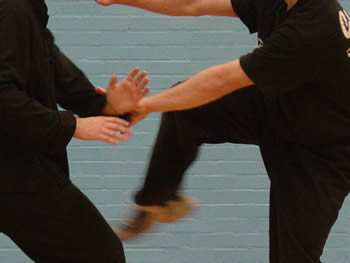
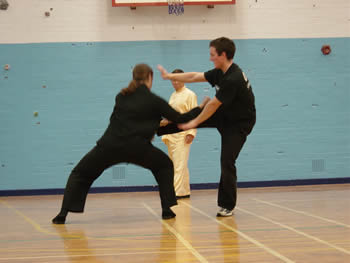
The first picture above is a close-up showing how Ronan “tames” Dan's hands before executing a whirlwind kick. Hand he not done so he would expose himself to much danger while attacking. Ron could do this spontaneously because he had practiced such a move hundreds of times in combat-sequence training.
Question 5
I am 14 years old. I have just begun reading your book, “The Art of Shaolin Kung Fu.” My dream is to become an expert martial artist in as many arts as I can, and I want to start with Shaolin Kung Fu.
— Clayton, Australia
Answer
I am much impressed by you. Despite your young age, you are not only respectful and write grammatically — surprisingly even some adults don't do this nowadays — you organize your ideas clearly, know what you want, and are willing to work hard to accomplish your aims. Your parents must be very proud of you.
I was like you before, in wanting to be an expert in as many martial arts as I could — Western Boxing, Judo, Karate, Taekwondo, Aikido, Hapkido, Kedo and Jujitsu. But as I deepened my skills in Shaolin Kungfu and expanded my knowledge, I realized that I could be an experts at all these martial arts, and more, by becoming an expert at Shaolin Kungfu, because all the skills and techniques found in these martial arts are also found in Shaolin Kungfu.
On the other hand, there are many skills and techniques in Shaolin Kungfu not found in other martial arts, such as Tiger-Claw, Cosmos Palm and One-Finger Zen. More significantly, there are many benefits in Shaolin Kungfu not available in other martial arts. For example, in many martial arts the health and ability of an expert deteriorate with age, but a Shaolin master is better at 60 than when he was 30. The most important and marvellous benefit is that Shaolin training is one of spiritual cultivation, whereas in many other martial arts the spirit is not involved, or not even believed to exist.
Nevertheless, as you are still young, before you have found a real Shaolin master, it would be a good idea to have some experience of as many martial arts as you can. Bear in mind that you should not injure your health, physically and psychologically, in whatever martial art you may train in. Deforming your hands in punching sandbags and becoming aggressive in sparring, for example, are injurious to health.

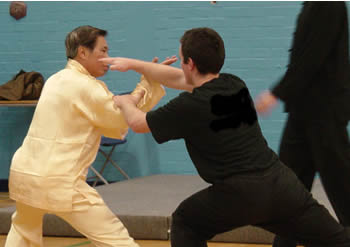
Ronan “threads” away Sifu Wong's Mirror Hand, and instantly follows up with “Fierce Tiger Speeds through Valley”. Sifu Wong retreats his fright leg backward into a left False-Leg Stance and responds with “Single Tiger Emerges from Cave”.
Question 6
After reading the first few chapters of your book, I have learned that I need to set aims and objectives. I've already begun doing so. I want to be able to
- defend myself against others
- learn an effective system for promoting health and fitness
- develop Kung Fu force and skills, especially internal strength
- acquire agility and fast reflexes
- learn one or more classical Kung Fu weapons
- overcome emotional problems, including stress
- acquire emotional/mental and wholesome qualities for personal development
- learn and practise effective techniques for meditation and methods of spiritual cultivation
- learn Kung Fu sets and patterns that are beautiful and flowing, but are powerful and effective
I understand it will require much time and practice to make all these things possible, and I am willing to go through all the training I have to. I also understand that I will require the three things, good methods, a good teacher, and being a good student.
Answer
The aims and objectives in the above list will serve as very useful guidelines for your training. Periodically assessing whether your training helps you to fulfil any one or more of the objectives and aims will enable you to be cost effective.
This will save you a lot of time. Many people practice what they think is kungfu for many years, without realizing that what they practice is actually not kungfu, which is a martial art, but some beautiful external kungfu forms for demonstration.
On the other hand, many people practice a martial art , such as Karate and Taekwondo, thinking that it will make them healthy, without realizing that their practice is actually injurious to their health, making them stressful and aggressive besides causing much internal injury.
Using good methods, learning from a good teacher and being a good student are the “three requirements of accomplishment” in any art. When you have these three requirements, you will have good results according to what the art you practice will give.
If your art is genuine Shaolin Kungfu, you will have good results of genuine Shaolin Kungfu. If your art is external Shaolin forms, although it may be called “genuine Shaolin Kungfu”, you will have good results of external Shaolin forms.
Hence, it is important to have a sound philosophy of what the art is. My books, “The Art of Shaolin Kung Ku” and a newer publication “The Complete Book of Shaolin” will give you some sound philosophy of what genuine Shaolin Kungfu is. The aims and objectives you have listed above are those that practicing genuine Shaolin Kungfu will fulfil.
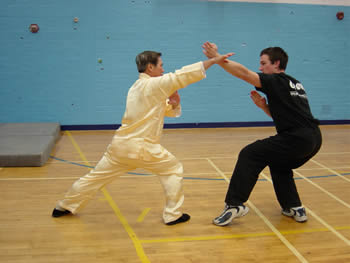
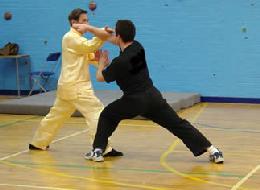
The two photographs above show Sifu Wong and Ronan engaged in free sparring. Sifu Wong attacks with “Poisonous Snake Shoots Venom”, and Ronan retreats his left leg backward and responds with “Golden Dragon Plays with Water”.
Question 7
The problem is there is no place I can go to that can teach me Shaolin Kung Fu. I cannot go to any schools in other countries to learn Shaolin Kung Fu. The only place that I can go to that can teach me some type of martial arts is a place called Shou Shu. I have researched the place a little and I have read that Shou Shu Kung Fu is related to Shaolin Kung Fu.
Answer
I have not heard of Shou Shu. In Romanized Chinese, the same word can have many meanings. If I interpret the two words correctly, they mean “Hand Techniques”.
It is worth giving it a try. Assess your training of Shou Shu with reference to your list of aims and objectives.
Question 8
I have not met the teacher yet, nor have I checked out their methods of teaching and stuff, but hypothetically speaking, if the place were to have a good teacher and method, would I be able to acquire all, or most of the things I need to become a good martial artist?
Answer
If the school has a good teacher and his method is good, and you are a good student, you will certainly have good results in Shou Shu. If Shou Shu is a martial art, you will be a martial artist. However, if Shou Shu is actually not a martial art, though it is said to be so, obviously you will never become a martial artist even though you may be good at Shou Shu.
The above statement may appear trite, but this is actually the main problem facing most kungfu or wushu students today. As I do not know what Shou Shu is, I shall give other examples which are common today. In all the examples, we shall presume the teachers are good, the methods are good, and you are a good student.
Suppose you learn at Tom's Wushu School. (“Wushu” is the Chinese term for kungfu.) You learn forms like “Changquan” (Long Fist) and “Nanquan” (Southern Fist), and weapon sets like “Daoshu” (Knife Technique) and “Jiangshu” (Spear Technique), and win a few championships. But you are not a martial artist because wushu is now practiced as a sport and not as a martial art, although the term means “martial art”.
Next you learn at Dick's Kungfu School, and practice traditional kungfu forms like “Lohan Fist”, “Five Animals” and “Tiger and Crane”, but you never spar. You are not a martial artist because you would be unable to defend yourself, although what you practice is called “kungfu”, and you can perform genuine traditional kungfu forms well.
Then you learn at Harry's Shaolin Kungfu School. Your training consists of push-ups, stretching, punching and kicking — which resemble the punching and kicking in Karate, Taekwondo and Kickboxing — and also a lot of free sparring. You are a martial artist, but not a Shaolin martial artist although you are supposed to have learnt Shaolin Kungfu. You would not have fulfilled the objectives and aims listed above except you can defend yourself, and are fast and flexible.
Now, as a martial artist, whether you are a good, mediocre or bad one will depend on what we consider a good, mediocre or bad martial artist is. Some people consider a person who can bash up his opponents easily to be a good martial artist, but I would consider him a bad one.
My opinion of a good martial artist is one who can accomplish most if not all the objectives and aims in your list, and his art need not necessarily be kungfu but his accomplishment must include combat efficiency, internal force, wholesome qualities for personal development, and preferably spiritual cultivation. One who can fight and is physically and psychologically healthy is a mediocre martial artist. One who can fight but is physically or psychologically unhealthy, like wanting to bash up others, is a bad martial artist.
If we use the criteria above, Harry's Shaolin Kungfu School and others like his will produce bad martial artists, even though the teachers, methods and students are good. The reason is that their martial artists will be unhealthy due to injuries sustained from their free sparring. At their best, they will produce mediocre martial artists because internal force and spiritual cultivation are not part of their training.
Hence, even if the teachers are good, their methods are good, and you are a good student, it is not easy to acquire all, or most of the things you need to become a good martial artist.
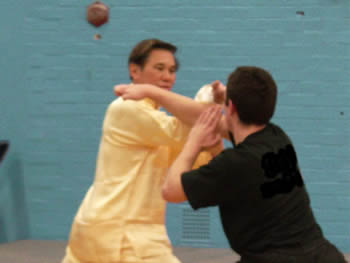
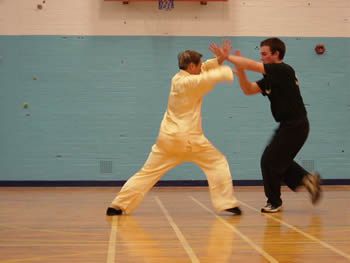
The first photograph above shows a close-up of Sifu Wong's “Beauty Looks at Mirror” which has been transformed from a defensive pattern to an attack, threatening Ronan.
Question 9
If I can acquire only most, then which ones can't I acquire, and are there any alternative ways for me to acquire them? The main things I want to acquire are internal force, health and fitness, and spiritual cultivation.
Answer
Ironically, the things you will find hard to acquire are the ones you want most, namely internal force, physical and psychological health, and spiritual cultivation.
Almost all martial arts will give you fitness, which may give you an appearance of health. But actually many martial artists are unhealthy! They are often aggressive, stressful or agitated, and suffer from internal injuries usually left unattended to from their free sparring.
Most martial artists today have no methodology for internal force training, and some do not believe in it. They normally derive their power from external and mechanical means, like muscle building, weight-lifting, rope skipping, running, punching sandbags, striking poles and other forms of hard conditioning.
Although many martial artists talk about spiritual cultivation, they may not really know what it is. To them it is cultivating qualities like having good manners, kindness and tolerance. But, strictly speaking, this is personality development, which is of course desirable, but it is not spiritual cultivation.
Spiritual cultivation is cultivating the spirit, which is also called the mind or the soul. Many martial artists do not believe that the spirit exists, and most martial arts do not even have a conceptual framework to describe or explain the spirit.
In my opinion, genuine traditional Shaolin Kungfu is the best martial art for developing internal force, promoting good physical and psychological health, and cultivating the spirit. But genuine traditional Shaolin Kungfu is very rare today. If you want to learn it, I would suggest you learn whatever wushu, kungfu or any martial art forms you can, then attend my Intensive Shaolin Kungfu Course when you are ready.
Meanwhile, to have some prior experience of kungfu, wushu or any martial art forms, practicing the kungfu patterns and sets in my book is a very useful preparation before attending my Intensive Shaolin Kungfu Course.
